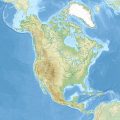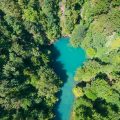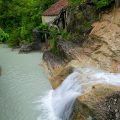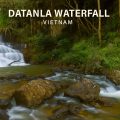River Source Explained: Types, Formation & Famous Origins
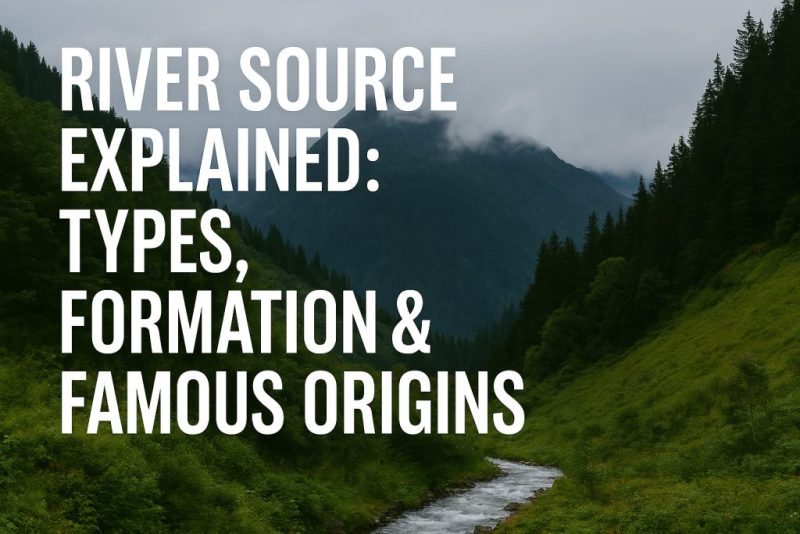
Discover what a river source is, how it forms, the types of sources from glaciers to karst springs, and why finding the true source—like the Amazon’s—is so complex.
A drop that falls from the sky, trickles from melting ice, or bubbles quietly from the earth. Somewhere—high in mist-draped mountains, deep within mossy forest springs, or hidden beneath the icy breath of a glacier—this is where rivers are born.
From these humble beginnings, they gather strength—fed by rain, snowmelt, underground flows, and countless tributaries. They wind through canyons, valleys, surge through plains, and shape the very skin of the Earth. Civilizations rise along their banks. Ecosystems thrive in their currents. But it all begins at the source: a place often remote, mysterious, and rarely seen, yet vitally important.
To understand a river, we must begin at its beginning. Let’s trace its path from that first drop onward—and explore the many ways rivers come into being.
What Is a River Source?
The source of a river is its starting point—the farthest place from which water begins to flow along a defined channel. It’s the quiet birthplace of something mighty. From here, the river begins its long journey toward the sea, gaining strength, carving valleys, and feeding ecosystems.
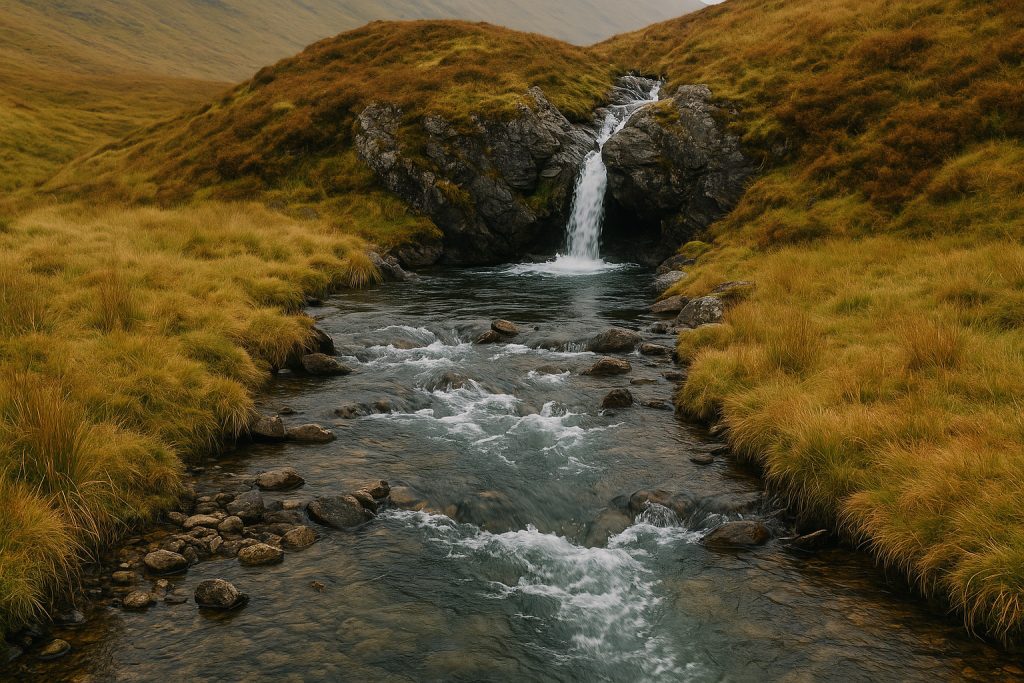
Types of River Sources
Not all river sources are the same—and neither are the rivers they create.
The origin of a river can dramatically shape its flow, color, speed, and even its ecological and cultural significance. Whether born from the steady trickle of a hidden spring or the roaring melt of an alpine glacier, each source carves out a unique identity for the river it becomes.
From crystal-clear spring waters bubbling up through limestone, to ephemeral rain-fed torrents that surge only with the seasons, the type of source tells us how the river lives—how it behaves, sustains life, and interacts with the landscape. Understanding these origins allows us to better appreciate not just the science of rivers, but the beauty and power of their journeys.
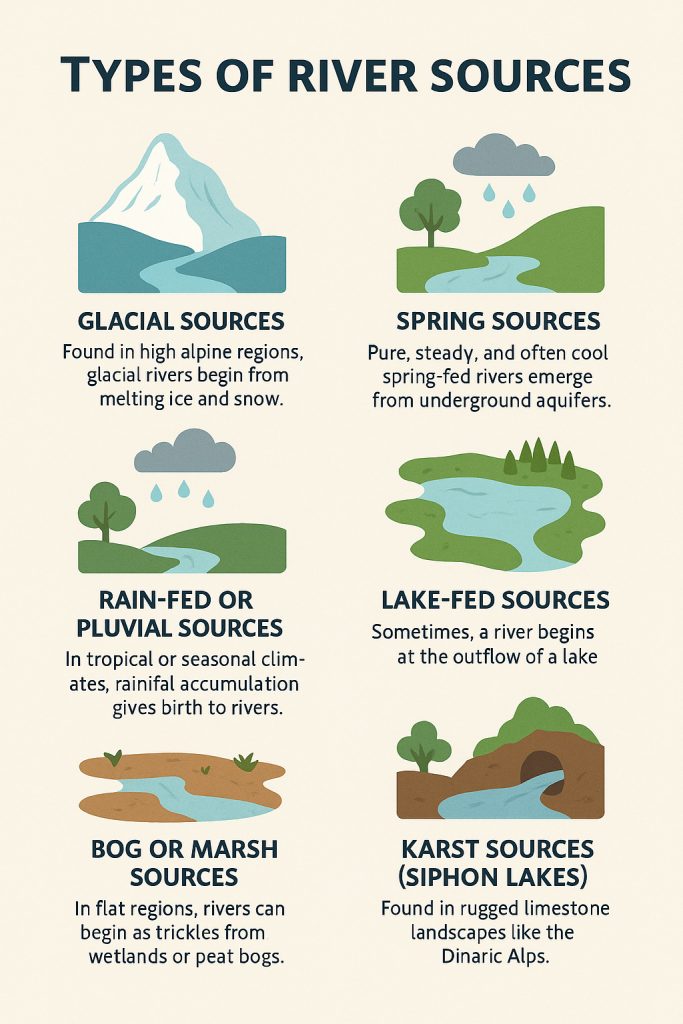
1. Glacial Sources
Glacial rivers are born in the silent, icy worlds of high-altitude mountain ranges. Their journey begins where ancient glaciers—massive, slow-moving rivers of ice—gradually melt under the warmth of the sun. As this frozen water transforms into liquid, it flows downward, gathering speed and volume to become the headwaters of some of the world’s mightiest rivers.
These rivers are often recognizable by their distinctive milky-blue or grayish color, caused by glacial flour—a fine sediment created as the glacier grinds rock into powder beneath its immense weight. Carried by the meltwater, this sediment clouds the river with a ghostly glow, a visible reminder of its powerful, frozen origins.
Glacial rivers tend to be cold, fast-moving, and highly seasonal, with peak flow in late spring and summer as snow and ice melt accelerates. They carve deep valleys and transport enormous amounts of sediment, reshaping landscapes and nourishing floodplains far downstream.
Examples:
-
The Rhône River in Switzerland, emerging from the Rhône Glacier in the Swiss Alps, begins its journey with striking turquoise waters that feed into Lake Geneva.
-
The Ganges River, one of the most sacred and significant rivers in the world, originates from the Gomukh glacier in the Indian Himalayas, where it begins as the Bhagirathi River.
These rivers, though icy at birth, breathe life into valleys, farmlands, and entire civilizations—flowing from the mountaintops to the sea, carrying stories written in ice and stone.
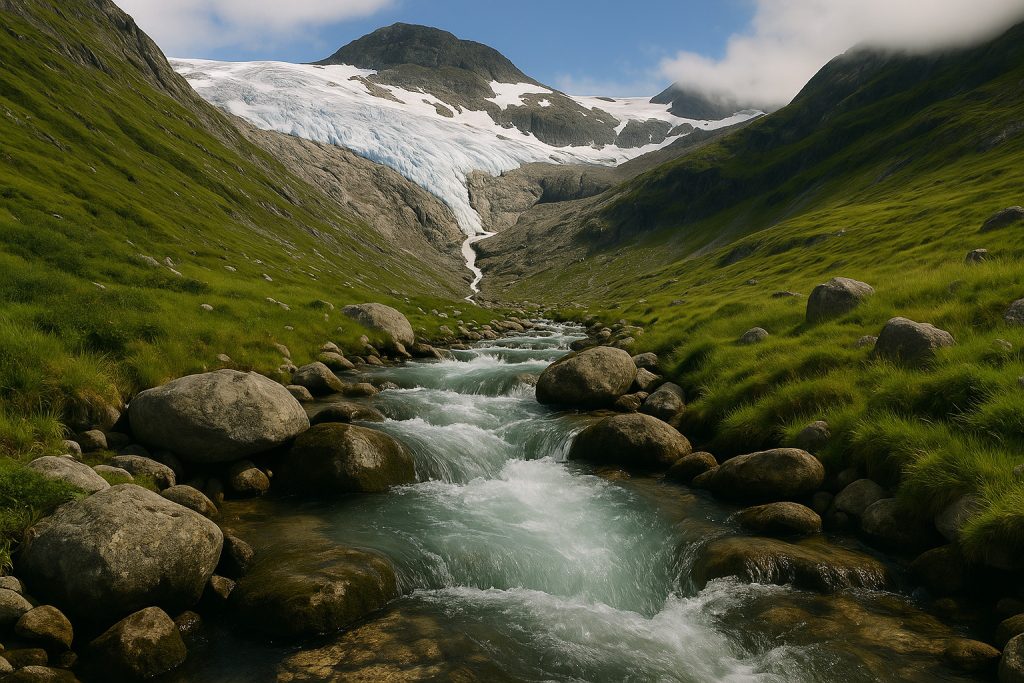
2. Spring Sources
Spring-fed rivers begin in the quiet places beneath our feet—emerging not from the sky or snow, but from the hidden veins of the Earth. These rivers are born when underground aquifers—natural reservoirs of water stored in porous rock or soil—find a break in the surface, releasing steady flows of water in the form of springs.
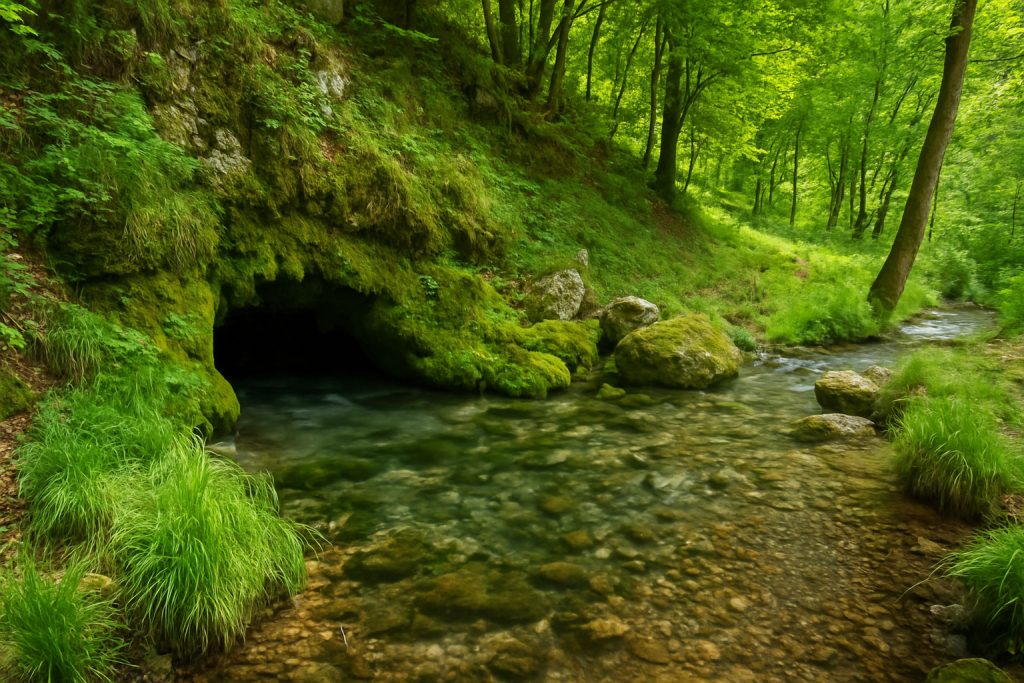
Unlike rivers driven by rainfall or melting glaciers, spring sources are often remarkably consistent. They maintain a stable flow and temperature year-round, which makes them lifelines for both human communities and fragile ecosystems, especially in dry or seasonally variable climates.
The water of spring-fed rivers is typically crystal clear, cool, and rich in minerals, having been filtered naturally through layers of rock and soil. These rivers often begin gently, as narrow streams that quietly gather strength, meandering through valleys, forests, or karst terrain.
Examples:
-
The Danube River, Europe’s second-longest, begins as a small stream emerging from a spring in the Black Forest of Germany—an unassuming beginning for such a mighty waterway.
-
The Jordan River, which holds profound historical and religious significance, originates from multiple springs in the foothills of Mount Hermon, where underground water meets the light of day.
Spring sources may lack the drama of thundering glaciers or torrential rainstorms, but their subtle constancy and clarity make them among the most dependable and revered beginnings in the natural world—quiet origins that sustain life across vast distances.
3. Rain-fed or Pluvial Sources
Some rivers are born not from melting ice or deep springs, but from the skies themselves. These rain-fed (pluvial) sources originate when seasonal or tropical rainfall accumulates across a landscape, gradually gathering into surface runoff that forms streams, rivulets, and eventually, full-fledged rivers.
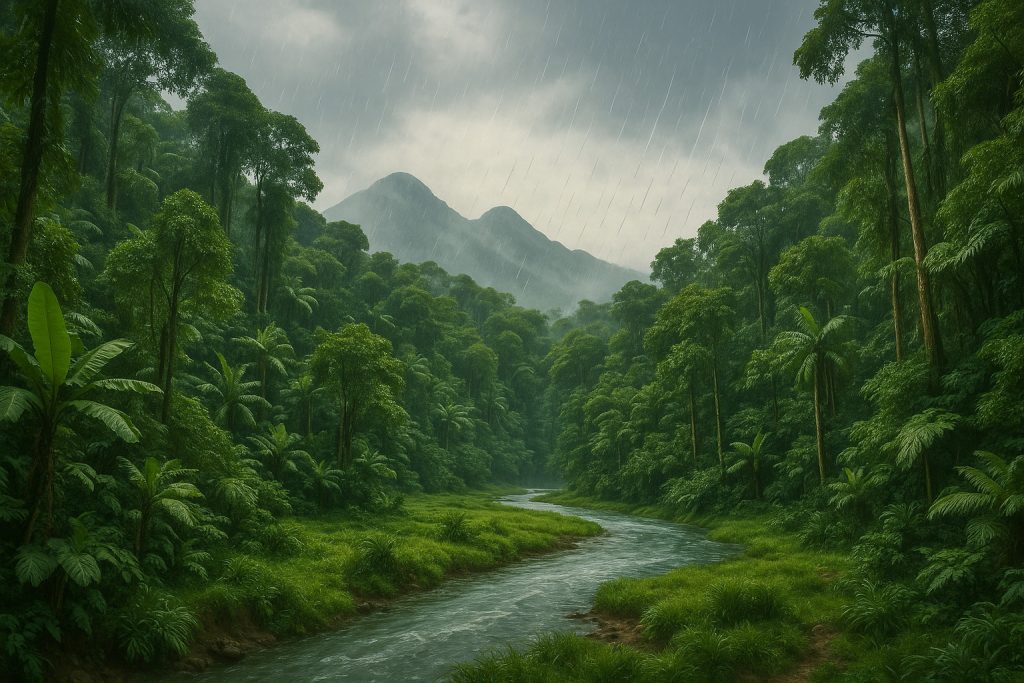
Unlike glacial or spring-fed rivers, which offer relatively stable year-round flow, pluvial rivers are often highly variable and unpredictable. Their very existence depends on weather patterns and seasonal monsoons. In the wet season, these rivers can swell into roaring torrents, transforming the land with floods, fertile silt, and fresh life. But come the dry season, they may shrink dramatically or vanish altogether, leaving behind sun-cracked beds and ghostly reminders of water’s temporary presence.
This impermanence gives pluvial rivers a rhythmic, pulsing nature, in tune with the cycles of the atmosphere. Their surrounding ecosystems and communities adapt accordingly—relying on them when they flow, and preparing for drought when they fade.
Examples:
-
Across sub-Saharan Africa, countless rivers such as tributaries of the Niger, Volta, and Senegal emerge from seasonal rainfall, flowing only during the wet months.
-
In South America, some tributaries of the Amazon, Orinoco, and countless smaller basins are similarly born from tropical rains, with flow patterns that surge and subside in response to regional monsoons.
These rivers remind us of nature’s ephemeral beauty—a system not of constancy, but of ebb and flow, where life thrives in cycles, and the source is renewed with each falling rain.
4. Lake-fed Sources
In some cases, rivers are born not from a spring or mountaintop, but from the outflow of a lake—a broad, reflective reservoir that gathers water from rainfall, glacial melt, or a network of incoming streams and tributaries. These lake-fed rivers begin their journey gently, often with a smooth, steady discharge of water that spills from the lake’s edge into a defined channel, marking the official start of a river’s course.
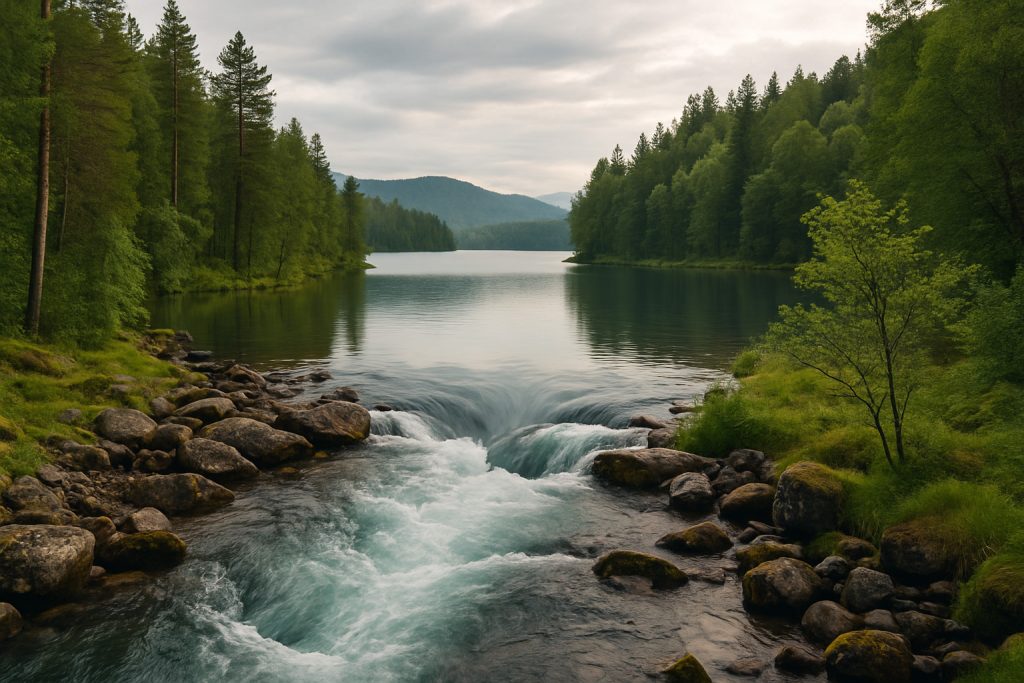
The beauty of lake-fed sources lies in their natural regulation. Lakes act as giant buffers, absorbing seasonal fluctuations in precipitation and meltwater, then releasing it in a more controlled and consistent flow. This makes many lake-fed rivers reliable for navigation, agriculture, and hydroelectric power, particularly in regions where rainfall is erratic or seasonal.
The characteristics of a lake-fed river are shaped by the nature of its lake—its size, depth, elevation, and inputs. A glacial lake may create a cold, mineral-rich river, while a rain-fed lowland lake might produce warmer, slower-moving waters. These rivers often begin with serene beginnings but may gather speed and volume as they descend through valleys and plains.
Examples:
-
The Nile River, the longest in the world, begins at Lake Victoria, which itself is fed by several tributaries. Though the name “Nile” starts here, hydrologists trace the true source even farther upstream, deep into Rwanda or Burundi—but Lake Victoria is widely recognized as its visible, named beginning.
-
The Neva River begins its journey from Lake Ladoga in Russia, the largest lake in Europe. It flows swiftly through St. Petersburg, eventually emptying into the Gulf of Finland.
Lake-fed rivers often form in tectonically or glacially carved basins, making them not just hydrologically important, but geologically fascinating as well. These rivers remind us that still waters don’t always stay still—for from the surface of a tranquil lake can rise a river that will flow for hundreds or even thousands of kilometers.
5. Bog or Marsh Sources
In the lowlands—where the land is flat, water lingers, and time itself seems to slow—some rivers find their beginnings not in dramatic bursts or icy torrents, but in the quiet, saturated stillness of bogs and marshes.
These wetland sources are subtle and elusive. Here, water doesn’t rush—it seeps. Rainfall and groundwater saturate the spongy soil, and over time, that water begins to gather, pooling into shallow channels that gently pull it forward. Often hidden beneath a blanket of reeds, sedges, and peat, these flows are slow-moving and often seasonal, their courses shifting with rainfall, vegetation growth, or even animal activity.
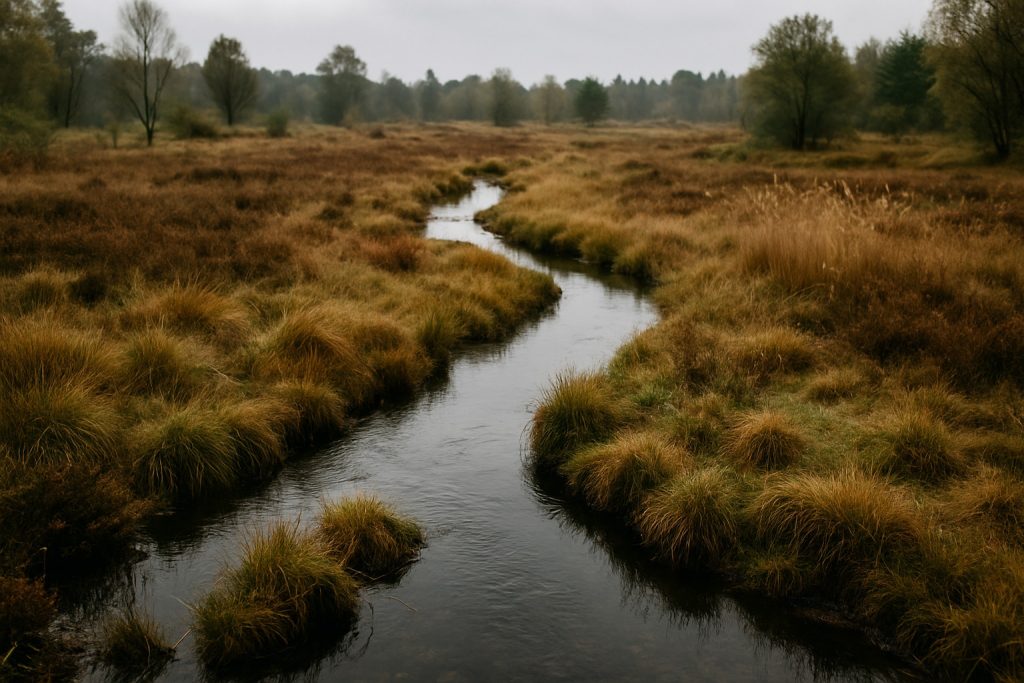
The water here is typically rich in organic matter, stained brown by tannins from decaying plants, and low in oxygen. These characteristics shape the unique chemistry and ecosystems of bog-fed rivers, which tend to be calm, nutrient-rich, and ecologically diverse.
Because there is no single point of emergence, defining the exact “source” in a marsh can be difficult. Instead of a spring or glacier, it might be a broad patch of peat, or a shallow basin that gradually narrows into a recognizable stream.
Examples:
-
The Vistula River, Poland’s longest river, traces its source to Barania Góra, where headwaters are formed partly through marshy highland terrain.
-
The Shannon River in Ireland begins in the Shannon Pot, a small spring that feeds a boggy area—its waters winding through marshland before becoming the country’s greatest river.
Bog and marsh sources may lack the grandeur of alpine glaciers or volcanic lakes, but they possess a quiet, ancient magic. They remind us that life’s great journeys don’t always begin with spectacle—sometimes, they begin in silence, among moss and mist.
6. Karst Sources (Siphon Lakes)
Among all river origins, karst sources are perhaps the most enigmatic and theatrical. Found in rugged limestone landscapes like the Dinaric Alps, these rivers are born in a world sculpted by water and stone—a world where the Earth is hollowed into vast cave systems, underground rivers, and mysterious sinkholes.
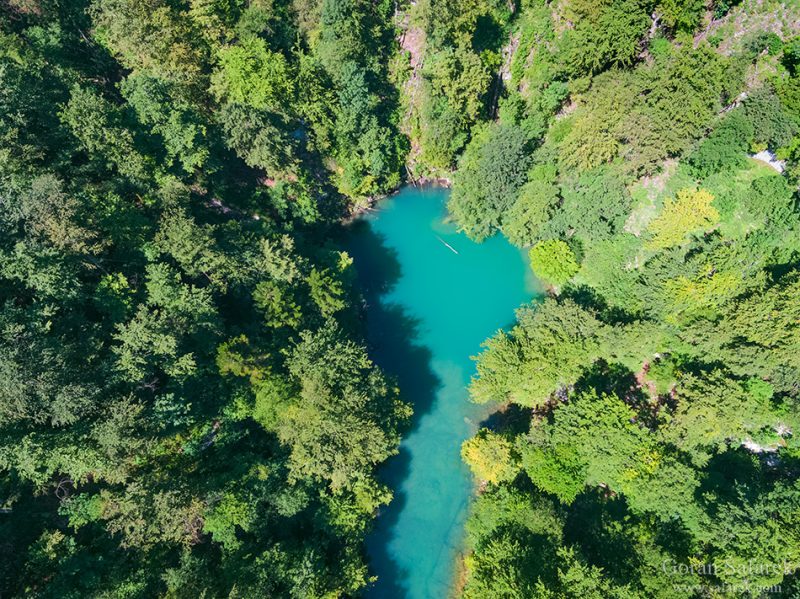
In karst terrain, water doesn’t follow the rules of surface flow. Instead, rain seeps into porous limestone, vanishing from sight and journeying through a labyrinth of subterranean passages. Deep below, it gathers in hidden chambers or underground lakes. When pressure builds or when the pathways connect to lower terrain, this water can surge upward in sudden bursts, emerging from cliffsides, rock walls, or the bottoms of lakes in violent, frothy flows.
Some karst rivers begin in siphon lakes—seemingly tranquil basins fed by these unseen forces. These lakes can rise or fall dramatically with the underground water table, and the river that emerges from them can be seasonal, fluctuating, or even intermittent. In extreme cases, the river may disappear underground entirely, only to resurface kilometers away, seemingly disconnected from its source.
Examples:
-
The Cetina River in Croatia bursts forth from a stunningly deep and colorful karst spring—a vertical abyss known as the “Eye of the Earth.”
-
The Buna River in Bosnia and Herzegovina emerges from a vast cave at the base of a towering cliff near the town of Blagaj—one of the most iconic karst springs in Europe.
-
The Trebišnjica River is notorious for disappearing underground and re-emerging multiple times, once earning it the title of the world’s longest sinking river.
Karst sources are theatrical, wild, and awe-inspiring—not just hydrologically fascinating, but deeply symbolic of nature’s secrets. They remind us that not all rivers run visible, and that even the most powerful forces can begin in darkness, pressure, and hidden motion beneath the Earth.
The Puzzle of Pinpointing a River’s True Source
Finding a river’s source can be surprisingly tricky.
Rivers rarely begin with a neat, bubbling spring. Especially in large watersheds, they often have multiple tributaries, lakes, seasonal flows, and changing names, which leads to debate over where the river truly begins.
One famous example? The Amazon River.
For decades, expeditions traced its origin through the Andes. In the 20th century and early 2000s, many scientists identified Nevado Mismi, a snow-capped mountain in Peru, as its most distant source. But in 2014, a new team pointed to the Mantaro River, also in Peru, which might be even farther from the Amazon’s mouth. The debate continues—just like the river. Read more about the Amazon River source: a century-long quest into its true origin.
But it’s not just a physical challenge. It’s a definitional one.
The U.S. Geological Survey (USGS) states that a river’s length can be measured either:
-
From the mouth to the most distant headwater, regardless of the stream’s name, or
-
From the mouth to the source of the stream known by the river’s name.
This distinction leads to surprises. For example, the Missouri River, while often called a tributary of the Mississippi, is actually longer than the Mississippi’s own upper course. Most geographers combine the two to create the longest river system in North America.
And then there’s naming tradition:
The Thames in England is traditionally said to begin at Thames Head, but the Churn tributary is actually longer—should it be called the River Churn all the way to London?
Most authorities today follow the longest continuous watercourse rule—the furthest point from the river mouth where water flows year-round, also called a perennial headwater. This excludes dry seasonal streams or temporary trickles that vary by month.
📚 The Smithsonian Institution and National Geographic Society both follow this logic when identifying sources of rivers like the Nile (which they trace not to Lake Victoria, but to the Kagera River feeding it) or the Amazon (beyond its named section, up through streams that change names several times).
In other words, the name on the map doesn’t always match the science.
Tracing River Sources with Modern Technology
From satellite imaging and GPS mapping to dye-tracing in karst systems, science has revolutionized how we locate and define sources.
🏔️ What Are Headwaters?
To understand the birth of a river, we must first journey to its headwaters—the true cradle of its flow.
The headwater of a river or stream is its geographic beginning. It’s the precise place where surface runoff—from rainfall, melting snow, or rising groundwater—starts to accumulate into a channel, forming a trickle, a rill, and eventually a defined stream.
But a river isn’t born from just one headwater. It’s a network of beginnings. In fact, every tributary of a river has its own headwater. And together, these dispersed origins form a hydrological web—a branching system of beginnings, merging toward a central flow.
Are a river’s source and its headwaters the same thing? Discover the answer in our post.
Source vs. Spring
Understanding the difference between a river’s beginning and one way it can begin
A source is the farthest point from a river’s mouth where its flow begins, while a spring is one type of source—where underground water surfaces and starts the flow. All springs can be sources, but not all sources are springs.
Sacred and Mythical River Sources
Many river sources have been revered as sacred places—portals between the earthly and the divine.
-
The Ganges is worshipped at its glacial source, Gomukh, where pilgrims trek for days.
-
The Nile’s mysterious origin fascinated ancient Greek and Roman geographers and was the subject of countless myths.
Explore how spiritual belief, pilgrimage, and folklore intersect with geography.
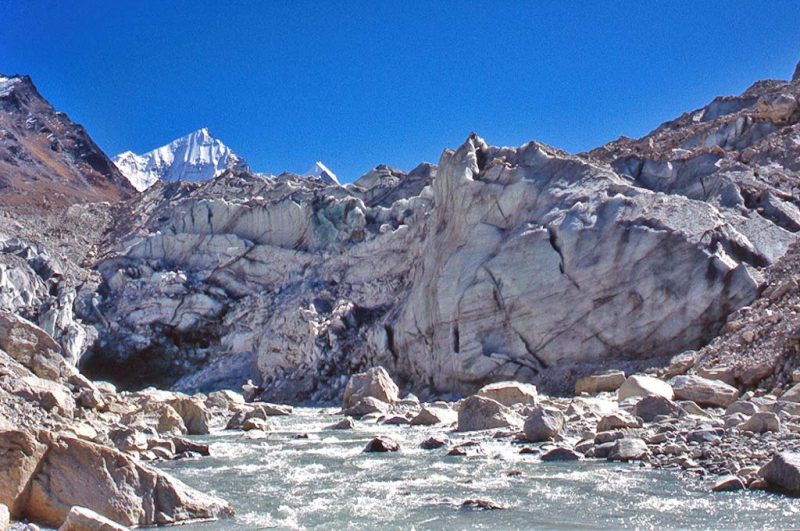
Biodiversity Hotspots at River Sources
River sources are often biodiversity microcosms—crucial for amphibians, endemic plants, and rare aquatic species.
Spring-fed areas especially can host ancient ecosystems because of their stable temperature and chemistry.
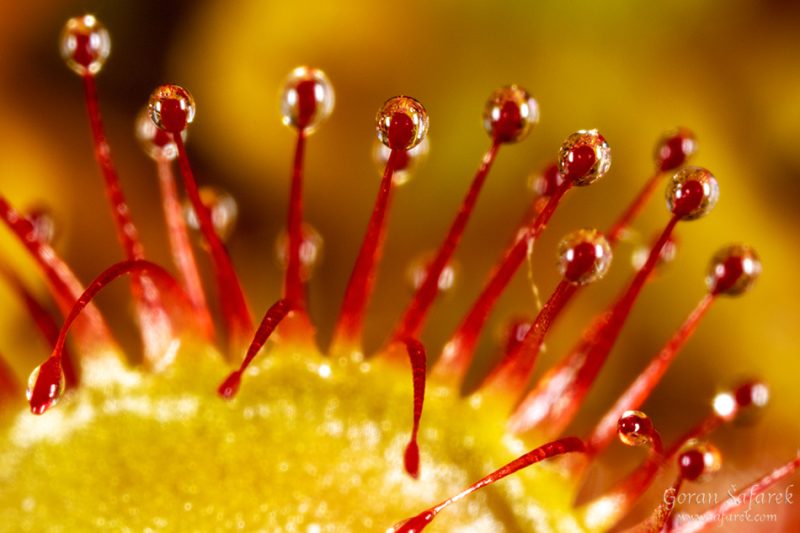
Disappearing River Sources
Some sources are vanishing—glaciers are retreating, aquifers are drying up, wetlands are being drained.
A powerful, urgent piece could explore the climate crisis through the lens of disappearing river beginnings.
Why It Matters
Understanding where rivers begin helps us protect their flow. These source regions are often fragile—vulnerable to climate change, pollution, and deforestation. And yet, they are sacred—cradles of civilizations and lifelines of landscapes.
Next time you stand by a mighty river, remember: it all started with a whisper in the hills.
